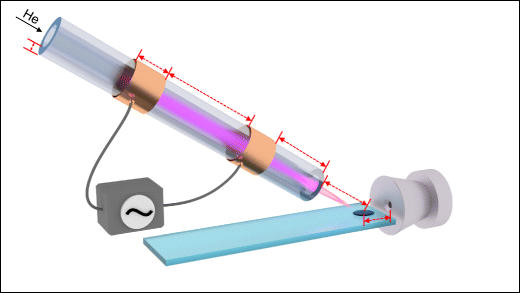Analytical and Bioanalytical Chemistry ( IF 3.8 ) Pub Date : 2018-04-13 , DOI: 10.1007/s00216-018-1033-7 Andreas Kiontke , Frank Holzer , Detlev Belder , Claudia Birkemeyer
Ambient ionization mass spectrometry (AI-MS), the ionization of samples under ambient conditions, enables fast and simple analysis of samples without or with little sample preparation. Due to their simple construction and low resource consumption, plasma-based ionization methods in particular are considered ideal for use in mobile analytical devices. However, systematic investigations that have attempted to identify the optimal configuration of a plasma source to achieve the sensitive detection of target molecules are still rare. We therefore used a low-temperature plasma ionization (LTPI) source based on dielectric barrier discharge with helium employed as the process gas to identify the factors that most strongly influence the signal intensity in the mass spectrometry of species formed by plasma ionization. In this study, we investigated several construction-related parameters of the plasma source and found that a low wall thickness of the dielectric, a small outlet spacing, and a short distance between the plasma source and the MS inlet are needed to achieve optimal signal intensity with a process-gas flow rate of as little as 10 mL/min. In conclusion, this type of ion source is especially well suited for downscaling, which is usually required in mobile devices. Our results provide valuable insights into the LTPI mechanism; they reveal the potential to further improve its implementation and standardization for mobile mass spectrometry as well as our understanding of the requirements and selectivity of this technique.

Optimized parameters of a dielectric barrier discharge plasma for ionization in mass spectrometry. The electrode size, shape, and arrangement, the thickness of the dielectric, and distances between the plasma source, sample, and MS inlet are marked in red. The process gas (helium) flow is shown in black
中文翻译:

低温等离子体电离的要求支持离子源的小型化
环境电离质谱法(AI-MS)是在环境条件下对样品进行电离的方法,可以快速而简单地分析样品,而无需或只需很少的样品准备工作。由于其简单的结构和较低的资源消耗,基于等离子体的电离方法尤其被认为是用于移动分析设备的理想选择。然而,试图确定等离子体源的最佳构型以实现目标分子的灵敏检测的系统研究仍然很少。因此,我们使用基于电介质势垒放电的低温等离子体电离(LTPI)源,其中氦气用作处理气体,以识别在等离子体电离形成的物质的质谱中最强烈影响信号强度的因素。在这项研究中,我们研究了等离子体源的几个与施工相关的参数,发现电介质的壁厚低,出口间距小以及等离子体源与MS入口之间的距离较短,才能通过以下过程获得最佳信号强度:气体流速低至10 mL / min。总之,这种类型的离子源特别适合缩小尺寸,这在移动设备中通常是必需的。我们的结果为LTPI机制提供了宝贵的见解;他们揭示了进一步改善其在移动质谱分析中的实施和标准化的潜力,以及我们对这项技术的要求和选择性的理解。等离子体源与MS进样口之间的距离要短一些,以实现最佳的信号强度,而工艺气体的流速应低至10 mL / min。总之,这种类型的离子源特别适合缩小尺寸,这在移动设备中通常是必需的。我们的结果为LTPI机制提供了宝贵的见解;他们揭示了进一步改善其在移动质谱分析中的实施和标准化的潜力,以及我们对这项技术的要求和选择性的理解。等离子体源与MS进样口之间的距离较短,以实现最佳信号强度,而工艺气体的流速低至10 mL / min。总之,这种类型的离子源特别适合缩小尺寸,这在移动设备中通常是必需的。我们的结果为LTPI机制提供了宝贵的见解;他们揭示了进一步改善其在移动质谱分析中的实施和标准化的潜力,以及我们对这项技术的要求和选择性的理解。我们的结果为LTPI机制提供了宝贵的见解;他们揭示了进一步改善其在移动质谱分析中的实施和标准化的潜力,以及我们对这项技术的要求和选择性的理解。我们的结果为LTPI机制提供了宝贵的见解;他们揭示了进一步改善其在移动质谱分析中的实施和标准化的潜力,以及我们对这项技术的要求和选择性的理解。

质谱中用于电离的介电势垒放电等离子体的优化参数。电极的大小,形状和排列,电介质的厚度以及血浆源,样品和MS进样口之间的距离用红色标记。黑色显示过程气体(氦气)流量











































 京公网安备 11010802027423号
京公网安备 11010802027423号